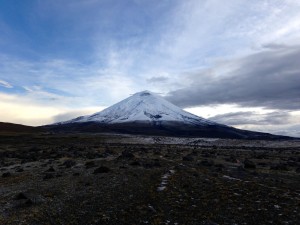| Tungurugua volcanic eruption on 1 February 2014. Image by Cedancp |
I’m on my way back to Bristol from a workshop in Ecuador on volcanic unrest, which culminated with an eruption simulation exercise. As my PhD is focused on unravelling the science behind volcanic unrest, these trips (this is the second of three with this specific aim) form a main focus for the real-world application of my research.
This workshop was split into 3 different parts. The first was a series of lectures on how volcanologists, social scientists, emergency managers, civil protection officials, and the general public interact during volcanic crises. Each specialist contributed their individual expertise, in my case as a volcanologist interpreting the signals that the volcano gives off, but the main message was that communication at all times between all parties must be especially clear. As with almost all lectures though, this part of the workshop obviously wasn’t the most exciting – especially with the inevitable jet-lagged tiredness kicking in for the first few days.
The second part of the workshop took us out into the field to explore two of Ecuador’s most famous volcanoes: Cotopaxi and Tungurahua. This was my favourite part! These are two quite epic volcanoes with the classical conical shape you imagine when you think of a volcano. By examining them in situ we learnt about the hazards they pose today to many nearby towns and cities. This really helps to put my research into perspective, as I know that by contributing to a better understanding of how volcanoes work I am helping to protect the people whose livelihood’s depend on the benefits the volcano brings them (for example, the more fertile soil).
 |
| Cotopaxi volcano, summit 5897 m ASL |
The final ‘update’ from the volcano: BIG eruption! I think we all could have predicted that – everyone likes a grand finale.
Despite the Hollywood firework finish, these exercises are crucial to prepare those individuals who will actually be in positions of responsibility when a true volcanic crisis develops. By playing out the different stages in as close to real-life as possible, strengths and weaknesses were highlighted that will allow for improvements to be made in the future. Improvements that may just save extra lives or livelihoods, and foster improved relationships between the public and the scientists trying to help them.
As one of those scientists, I was just happy enough to be able to take part.
------------------
Cabot Institute member James Hickey is a final year PhD student in the School of Earth Sciences. His research is focused on unravelling the mechanisms that cause volcanoes to become restless prior to eruptions. Ultimately, the aim is to improve our understanding of precursory signals to enhance forecasting and mitigation efforts.
 |
| James Hickey |
This blog has been republished with kind permission from the Bristol Doctoral College. View the original blog post.
If you would like to study a PhD at the University of Bristol, please visit the Univeristy's scholarships page.
